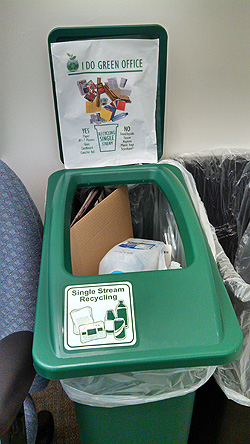Single Stream Recycling for New England Communities
![]() Each Monday we write about the New England environment and way of life seen through our local perspective. Previous posts
Each Monday we write about the New England environment and way of life seen through our local perspective. Previous posts
By Amy Miller
I stand there staring into the bin of crushed white office paper and newspaper, unwilling to let go of my empty diet soda can. I am supposed to toss it in. I know that this is where our recyclables go now. But old habits die hard. And I have been trained – finally – to sort my plastics, papers, cans and glass into an array of containers, so I am having trouble throwing them together to let some far-off machine undo this miasma.
But our office has gone to what’s called “single stream recycling” and this is what I must do.
You would think it would be easy, a no-brainer. And in the end, it certainly simplifies things to be collecting all bottles, papers and cans into the same bin.
Statistics bear this out. For instance, the town of Wilton, Maine, switched to single stream recycling last fall. It will save thousands of dollars a year, according to the Portland, Maine, newspaper.
Early stats find Wilton residents throwing away 5.5 to 8.5 tons less trash each month and recycling about that much more. Town officials translated this into a savings of anywhere from $4,200 to $6,600 a year. This savings is attributed to the fact that it costs about $65 a ton to dispose of trash and $33 a ton to get rid of recyclables.
And Wilton is far from alone.
According to Massachusetts environmental officials, single stream recycling began on the west coast 10 years ago and reached the Commonwealth in 2006. About 30 Massachusetts communities have converted to single stream, and more are planning the conversion.
The Connecticut Resources Recovery Authority reported it has increased diversion rates (the amount diverted from trash to recycling) for six straight years, largely thanks to single-stream recycling.
I joined a group of EPA employees last year to see how single stream recyclables get separated. The giant machinery involved gravity, wind, filters, conveyor belts and lots of workers removing plastic bags.
Huge truckloads of cans, jars, newspaper, office paper, yogurt containers and you- name-it were dumped on conveyor belts and sorted into separate piles, with only a few alien pieces in each collection.
And so slowly I am adjusting. I have learned the joy of throwing my cans and cups in one container I still feel like I am littering, but at least I get to feel good about it.
About the author: Amy Miller is a writer who works in the public affairs office of EPA New England in Boston. She lives in Maine with her husband, two children, seven chickens, two parakeets, dog and a great community.
Editor's Note: The opinions expressed in Greenversations are those of the author. They do not reflect EPA policy, endorsement, or action, and EPA does not verify the accuracy or science of the contents of the blog.

Small things will always become big when accumulated slowly. One way or the other it will grow into something that we couldn’t even realize. It is like recycling. We can save money and energy in small amounts but if we continue doing it, it will save us lots of money and energy in the future.